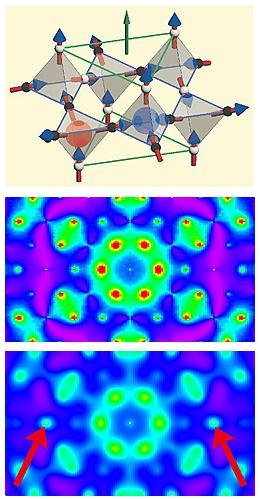Oct 6 2009
Any child can tell you that a magnet has a "north" and a "south" pole, and that if you break it into two pieces, you invariably get two smaller magnets with two poles of their own. But scientists have spent the better part of the last eight decades trying to find, in essence, a magnet with only one pole. A team working at the National Institute of Standards and Technology (NIST) has found one.*
 Magnetic monopoles are created (top) when the spin of an ion in one corner of a spin ice crystal is knocked askew, creating a monopole (red sphere) and adjacent antimonopole (blue sphere). Neutron scattering at the NCNR allowed the team to see the spin ice's transition from its normal state (center) to the monopole state. Monopoles scatter neutrons in a telltale fashion indicated by the red arrows in (bottom.) Credit: NIST
Magnetic monopoles are created (top) when the spin of an ion in one corner of a spin ice crystal is knocked askew, creating a monopole (red sphere) and adjacent antimonopole (blue sphere). Neutron scattering at the NCNR allowed the team to see the spin ice's transition from its normal state (center) to the monopole state. Monopoles scatter neutrons in a telltale fashion indicated by the red arrows in (bottom.) Credit: NIST
In 1931, Paul Dirac, one of the rock stars of the physics world, made the somewhat startling prediction that "magnetic monopoles," or particles possessing only a single pole-either north or south-should exist. His conclusion stemmed from examining a famous set of equations that explains the relationship between electricity and magnetism. Maxwell's equations apply to long-known electric monopole particles, such as negatively charged electrons and positively charged protons; but despite Dirac's prediction, no one has found magnetic monopole particles.
Now, a research team working at NIST's Center for Neutron Research (NCNR), led by Hiroaki Kadowaki of Tokyo Metropolitan University, has found the next best thing. By creating a compound that under certain conditions forms large, molecule-sized monopoles that behave exactly as the predicted particles should, the team has found a way to explore magnetic monopoles in the laboratory, not just on the chalkboard. (Another research team, working simultaneously, published similar findings in Science last month.**)
"These are not the monopole particles Dirac predicted-ours are huge in comparison-but they behave like them in every way," says Jeff Lynn, a NIST physicist. "Their properties will allow us to test how theoretical monopole particles should behave and interact."
The team created their monopoles in a compound made of oxygen, titanium and dysprosium that, when cooled to nearly absolute zero, forms what scientists call "spin ice." The material freezes into four-sided crystals (a pyramid with a triangular base) and the magnetic orientation, or "spin," of the ions at each of the four tips align so that their spins are balanced-two spins point inward and two outward. But using neutron beams at the NCNR, the team found they could knock one of the spins askew so that instead three point in, one out ... "creating a monopole, or at least its mathematical equivalent," Lynn said.
Because every crystal pyramid shares its four tips with adjacent pyramids, flipping the spin of one tip creates an "anti-monopole" in the next pyramid over. The team has created monopole-antimonopole pairs repeatedly in a relatively large chunk of the spin ice, allowing them to confirm the monopoles' existence through advanced imaging techniques such as neutron scattering.
While the findings will not tell the team where in the universe to search for Dirac's still-elusive magnetic monopole particles, Lynn says that examining the spin ice will permit scientists to test certain predictions about monopoles. "Maxwell's equations indicate that monopoles should obey Coulomb's Law, which indicates their interaction should weaken as distance between them increases," he says. "Using the spin ice crystals, we can test ideas like this."
* H. Kadowaki, N. Doi, Y. Aoki, Y. Tabata, T.J. Sato, J.W. Lynn, K. Matsuhira and Z. Hiroi. Observation of magnetic monopoles in spin ice. Journal of the Physical Society of Japan,78, No. 10, Oct. 13, 2009. (The team first presented their findings in an invited talk at the International Conference on Neutron Scattering in May 2009.)
** D. J. P. Morris, et al. Dirac strings and magnetic monopoles in spin ice Dy2Ti2O7. Science, online publication Sept. 3, 2009.